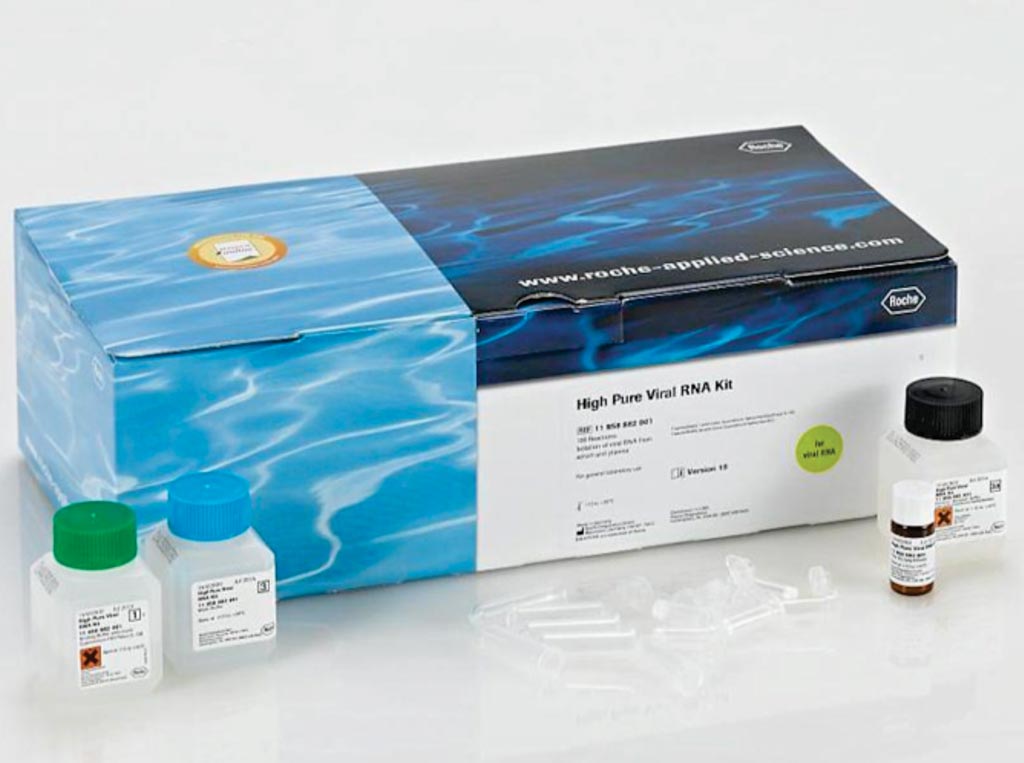Enterovirus D type 111 Genetically and Phenotypically Characterized
By LabMedica International staff writers
Posted on 06 Nov 2019
Members of the species Enterovirus D (EV-D) remain poorly studied. The two first EV-D types (EV-D68 and EV-D70) have regularly caused outbreaks in humans since their discovery five decades ago but have been neglected until the recent occurrence of severe respiratory diseases due to EV-D68.Posted on 06 Nov 2019
The three other known EV-D types (EV-D94, EV-D111 and EV-D120) were discovered in the 2000s-2010s in Africa and have never been observed elsewhere. One strain of EV-D111 and all known EV-D120s were detected in stool samples of wild non-human primates, suggesting that these viruses could be zoonotic viruses.

Image: The High Pure Viral RNA Kit is for general laboratory use and purifies viral RNA from a variety of samples such as serum and plasma (Photo courtesy of Roche Diagnostics).
Virologists at the Institut Pasteur (Paris, France) and their international colleagues isolated four EV-D111s that had been in cell cultures from stool samples of children with acute flaccid paralysis in the framework of poliovirus surveillance. Viral RNAs were extracted from cell culture supernatants with the High Pure Viral RNA kit (Roche Diagnostics, Risch-Rotkreuz, Switzerland). Virus genomes were amplified by reverse transcription polymerase chain reaction (RT-PCR) with generic primers and the products were sequenced using Illumina NextSeq HiSeq (Illumina, San Diego, CA, USA).
The acid sensitivity assay was performed on EV-D111 OUP-05-059, using EV-D68 Fermon and EV-D70 J670/71, which are known to be acid-sensitive and acid-resistant, respectively as controls. The ability of EV-D111 OUP-05-059 to produce cytopathic effect in different cell lines was assessed in 96-well plates. To determine whether EV-D111 grows in L cells, L cells were cultivated in 24-well plates until confluence. Anti-CD155 monoclonal antibody were produced and used for immunofluorescence and infectivity inhibition assays.
The team observed that the EV-D111 strains from human samples and the unique simian EV-D111 strain were not phylogenetically distinct, thus suggesting a recent zoonotic transmission. They also discovered evidences of probable intertypic genetic recombination events between EV-D111s and EV-D94s. As recombination can only happen in co-infected cells, this suggests that EV-D94s and EV-D111s share common replication sites in the infected hosts. These sites could be located in the gut since the phenotypic analysis they performed showed that, contrary to EV-D68s and like EV-D94s, EV-D111s are resistant to acid pH.
The scientists also found that EV-D111s induce strong cytopathic effects on L20B cells, a cell line routinely used to specifically detect polioviruses. An active circulation of EV-D111s among humans could then induce a high number of false-positive detection of polioviruses, which could be particularly problematic in Central Africa, where EV-D111 circulates and which is a key region for poliovirus eradication. The authors concluded that their results show that EV-D111s are probably enteric viruses and evolve by exchanging genetic sequences with EV-D94.The study was published on October 17, 2019, in the journal PLOS Neglected Tropical Diseases.
Related Links:
Institut Pasteur
Roche Diagnostics
Illumina














